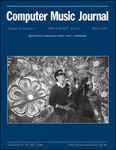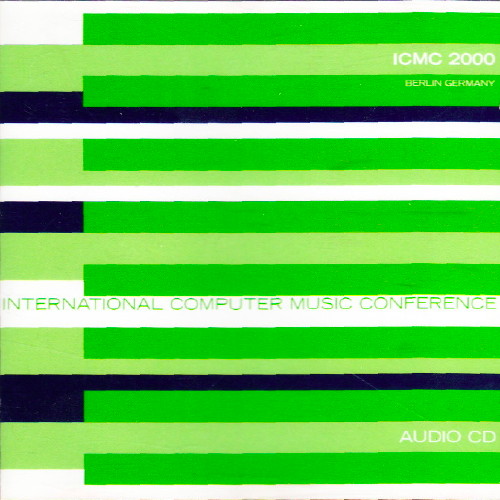Klick auf das Bild führt zum Shop
Traverse 1999 Program Note, ICMC 2000
Composer: Vincent Royer and Gerhard Eckel
Label: Hochschule der Künste, Berlin
ASIN:
Format: Audio CD
Release Date: 02 Jun 1999
Shop: Amazon .de .com .fr
Computer Music Journal – Summer 2001

Traverse (1999), by Gerhard Eckel (Austria) and Vincent Royer (France), was for me one of the major highlights of the conference. For perhaps the first time I witnessed a viola and a notebook computer performing together on stage in a fully integrated manner. Here the computer truly became a live instrument.
Reviewed by Thomas Gerwin (Berlin, Germany)
>>> ganzen Artikel lesen
Improvisation for Viola and Computer
Traverse is an improvisation piece for a viola player and a computer player. The latter plays a Max/MSP patch especially developed for the piece and running on a Macintosh G3 PowerBook. The basic idea of Traverse was to create a situation allowing for a close interaction between the two very different instruments and players. The goal was to really play together, not just share the stage! One motivation for our approach was the simple fact that laptop computers recently became powerful enough to synthesize and process sound in real-time and at a quality decent enough to match up with real instruments. The possibility of only plugging in the PowerBook and play was just too seducing. Finally, electronic musicians become almost as flexible as other instrumentalists. We can meet up for rehearsals easily since we can carry everything we need and we can even go on developing our instrument while rehearsing, which we found to be essential. But there were also other motivations that drove our approach. The question we asked with Traverse was “How is it possible to play music with a typewriter interface and a 2D point-and-click device?” The idea of using any other special type of interface was voluntarily excluded. Evidently, the constraints of playing with the mouse and the computer keyboard played an important role in the design of the computer part, which can be thought of an algorithmic instrument. The computer player controls his or her part more on a structural level than by creating individual events. Only in certain situations, precise rhythmical interaction between the two players is needed and then individual events are directly triggered from the keyboard or produced by mouse movements (e.g. “scrubbing” samples). For most of the time, the computer player plays parameters of structure generators, which control a simple signal processing engine using a large sample base, which has been recorded with the viola player over the last years. A key element in the design of the instrument patch is a certain amount of indeterminacy with respect to the playerís control. This was found very inspiring for the improvisation because it sometimes allows escaping the horizon of oneís own imagination. Surprises and accidents are very important in Traverse and make part of the joy of playing it. Of course, they have to be kept under a certain amount of control and this is exactly what we had to find out and fine-tune during the rehearsals ? thanks to current computer music technology we finally can do so. Traverse follows a very simple and pragmatic technological approach leaving enough space for experimenting, playing, and actually making music.
Produced at GMD – German National Research Center for Information Technology.
Premiered at the Kunstmusem Bonn, June 2nd 1999.
Source: https://iem.at/~eckel/art/Traverse/ICMC2000.html
Tracklist
- Horacio Vaggione – Agon {8:47}
- Cort Lippe – Music for Hi-Hat & Computer {13:52}
- Marc Ainger – Shatter {8:07}
- Agostino di Scipio – 5 Difference-Sensitive Circular Interactions (1) {1:36}
- Agostino di Scipio – 5 Difference-Sensitive Circular Interactions (2) {2:20}
- Agostino di Scipio – 5 Difference-Sensitive Circular Interactions (3) {2:19}
- Agostino di Scipio – 5 Difference-Sensitive Circular Interactions (4) {2:19}
- Agostino di Scipio – 5 Difference-Sensitive Circular Interactions (5) {3:01}
- Richard Nance – Between Dog and the Wolf {5:34}
- Gerhard Eckel & Vincent Royer – Traverse {11:18}
